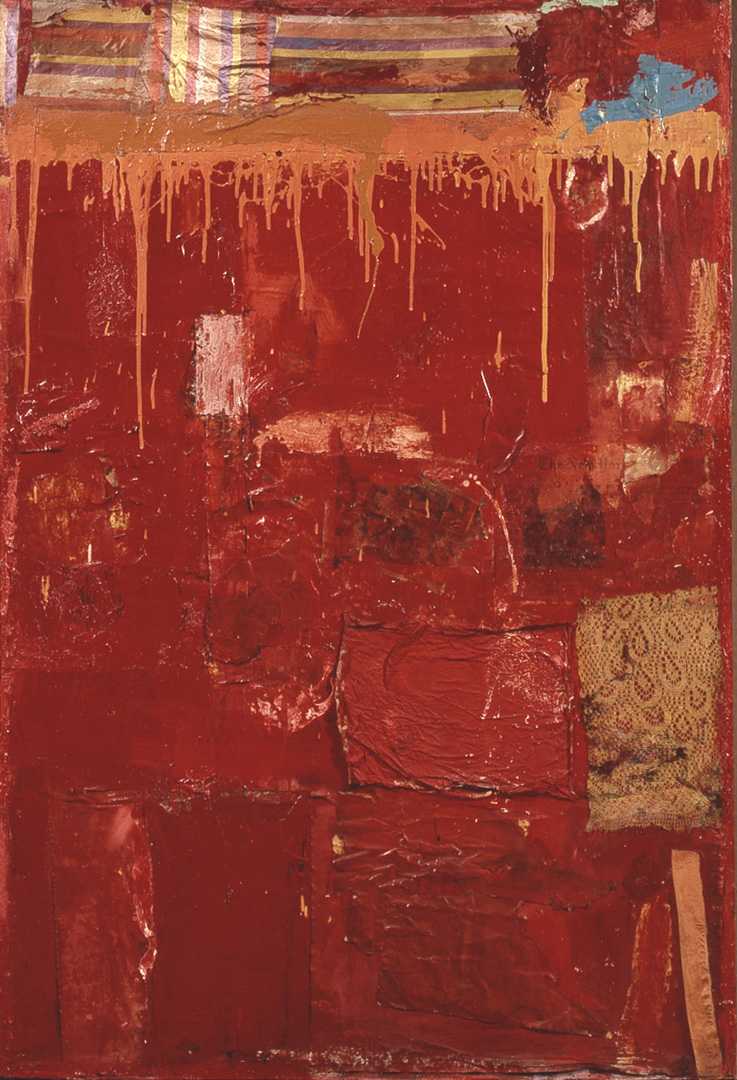
Untitled
NARRATOR
Eli Broad.
ELI BROAD
Acquiring this painting represented a big turning point for us. It was 1983, and we traded our van Gogh drawing so we could get it. That was at the time when we really committed to collecting contemporary art.
NARRATOR
This painting is drenched in red paint.
[LONG PAUSE]
But there are other details to look out for: a daub of blue, drips of orange, and pieces of cloth applied to the canvas. Art historian Katy Segal, at The Broad’s UnPrivate Collection talk.
KATY SEGAL AUDIO
The artist was extraordinarily empathetic in responding to things, whether a color, like the red we see here, a pattern, a heron or even a door.
NARRATOR
Joanne Heyler.
JOANNE HEYLER
Rauschenberg’s work brings the news, so to speak, and is always laced with clues to the artist’s life as it existed in the very moment the artwork was made. In this case, if you look carefully, you would find a newspaper with a date on it, of 1954.
NARRATOR
The materials collaged into this work form a snapshot of what Rauschenberg encountered as he made this painting. The front page of the New York Times and the comic strip from the time called “Pogo” from the same paper. Rauschenberg had a voracious appetite for material culture and making it part of his art.
As Rauschenberg famously said: “Painting relates to both art and life. Neither can be made. (I try to act in that gap between the two.)”
It may seem that this work stands just between pop art and abstract expressionism and here there are elements of both. But Rauschenberg didn’t care to explain himself with art historical labels.
Robert Rauschenberg had a voracious appetite for material culture. A collage of wood, newspaper, comics, sundry clothes, and old lace, Untitled is saturated with a coat of red paint. The surface is open to drips and chance combinations, not with an expressive intent as in abstract expressionism but with a field of unexpected juxtapositions and perceptual shifts. Untitled was an important step in Rauschenberg’s development as an artist; his use of everyday objects continued to evolve, eventually resulting in a hybrid of painting and sculpture now known as Combine paintings.
When Eli and Edythe Broad acquired Rauschenberg’s Untitled in 1983, they traded Vincent van Gogh’s drawing Cabanes à Saintes-Maries, 1888, which they had cherished for a long time. For the Broads, Untitled represents a turning point in their lives as collectors, a symbol of their increasing commitment to the works of contemporary artists.
Robert Rauschenberg, along with Jasper Johns and Cy Twombly, broke the stylistic and conceptual dominance of abstract expressionism in the 1950s and expanded the horizons of art. Rauschenberg is perhaps best known for two bodies of work, his Combines of the 1950s and his silkscreen paintings, which he began in the early 1960s. These works preceded and helped inspire pop art as well as an increased blurring and retooling of the various media of the visual arts. Rauschenberg has also been a great ambassador for the visual arts, both as a famous collaborator in John Cage and Merce Cunningham’s dance compositions and as an international teacher with the Rauschenberg Overseas Cultural Interchange (R.O.C.I.), an organization that in the 1980s brought art projects and new art-making technologies to foreign countries.
Rauschenberg’s Combines are a hybrid between painting and sculpture. In these works, Rauschenberg mixes items found in alleys, on the streets, or in junk stores with paint and other materials of art making. Partially because of his use of such ordinary items, Rauschenberg has become known as an artist who, in his own words, “works in the gap between art and life.” An early manifestation of this mode and a key work in his career is Untitled, 1954. A collage of wood, newspaper, comics, sundry clothes, and old lace, Untitled is saturated with a thick sealing coat of paint. The surface is open to drips and chance combinations, not with an expressive intent as in abstract expressionism but instead with a field of unexpected juxtapositions and perceptual shifts.
Untitled, 1963, denotes Rauschenberg’s gradual shift to silkscreen painting in the early 1960s. The various images of John F. Kennedy, weather balloons, instruments, and plates, as in the Combines, create a field of association not unlike the deluge of information found in a newspaper or on television. The viewer’s eye revolves around the canvas, picking up symbols and visual clues, enacting a day-to-day perception not provided by the rigorous painting composition but by the often random collection of objects and images that one encounters just walking down the street. The introduction of this way of seeing into fine art is one of Rauschenberg’s most important contributions, loosening long-held traditions of painting.